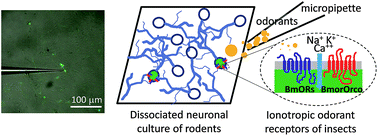Dissociated neuronal culture expressing ionotropic odorant receptors as a hybrid odorant biosensor—proof-of-concept study
Abstract
Artificial odorant sensors generally perform poorer than olfactory systems in living organisms. The excellent performances of living odorant systems are achieved by the molecular recognition abilities of odorant receptors and the neuronal information processing that follows. To take advantages of this, here we propose a novel hybrid odorant biosensor by means of expressing ionotropic odorant receptors of insects into dissociated neuronal cultures of rodents. This combination of materials brings significant advantages such as easy functional expression, prolonged lifetime, and an ability to amplify the weak ionic currents of odorant receptors. In the present work,


 Please wait while we load your content...
Please wait while we load your content...